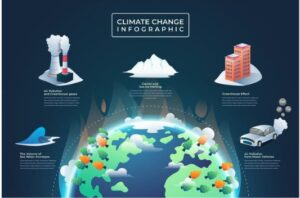Weather
The Impact of Climate Change on Extreme Weather Events
Understanding Climate Change and Extreme Weather
Climate change refers to long-term shifts and alterations in temperature and weather patterns. It is primarily caused by the increase in greenhouse gases, such as carbon dioxide (CO2), methane (CH4), and nitrous oxide (N2O), which trap heat in the Earth’s atmosphere. This phenomenon, known as the greenhouse effect, leads to global warming and disrupts normal climate patterns.
Extreme weather events are defined as severe or unusual weather conditions that deviate significantly from the average. These events include hurricanes, typhoons, heatwaves, floods, droughts, and severe storms. While extreme weather can occur naturally, climate change is amplifying these events, making them more frequent and intense.

The Connection Between Climate Change and Extreme Weather
1. Increased Temperature and Heatwaves
One of the most direct impacts of climate change is the rise in global temperatures. As the Earth’s average temperature increases, so does the likelihood of heatwaves. Heatwaves are prolonged periods of excessively high temperatures that can have severe health impacts, including heat exhaustion and heatstroke. Studies show that the frequency, duration, and intensity of heatwaves have increased significantly over the past few decades, largely due to climate change.
2. More Intense Hurricanes and Cyclones
Hurricanes and cyclones are fueled by warm ocean waters. As global temperatures rise, ocean waters also warm up, providing more energy for these storms. This increased energy can lead to more intense hurricanes and cyclones, characterized by higher wind speeds and more rainfall. Research indicates that the frequency of the most intense hurricanes and cyclones has increased, and future projections suggest that these storms will continue to grow in strength.
3. Intensified Precipitation and Flooding
Climate change is also leading to more intense precipitation events. Warmer air holds more moisture, which can lead to heavier rainfall and increased risk of flooding. Regions that experience extreme rainfall are more susceptible to flash floods, river floods, and coastal flooding. For instance, recent years have seen record-breaking rainfall events that have caused devastating floods in various parts of the world.
4. Increased Droughts and Water Scarcity
While some areas are experiencing more intense precipitation, others are facing prolonged periods of drought. Climate change can alter precipitation patterns, leading to reduced rainfall in some regions. This reduction in water availability can cause severe droughts, affecting agriculture, water supply, and ecosystems. Droughts can lead to crop failures, food shortages, and increased competition for water resources.
5. Changing Weather Patterns and Storm Tracks
Climate change can also shift weather patterns and storm tracks. As the climate warms, the jet stream—a high-altitude wind pattern that influences weather—can become wavier, leading to prolonged periods of unusual weather. For example, regions that typically experience mild winters may face colder conditions due to changes in storm tracks. These shifts can have significant impacts on local weather patterns and increase the likelihood of extreme weather events.
Implications for Communities and Ecosystems
The impacts of extreme weather events can be devastating for both human communities and natural ecosystems.
- Human Health and Safety: Extreme heat can exacerbate pre-existing health conditions, leading to increased mortality rates. Flooding can cause injuries, displacements, and contamination of water supplies. Droughts can lead to food and water shortages, affecting nutrition and overall well-being.
- Economic Costs: Extreme weather events can have significant economic costs. The damage to infrastructure, homes, and businesses from hurricanes, floods, and wildfires can be substantial. The costs of rebuilding and recovery can strain local and national economies.
- Ecosystems and Biodiversity: Extreme weather can disrupt ecosystems and threaten biodiversity. Flooding can erode habitats, while droughts can lead to habitat loss and increased risk of wildfires. Changes in weather patterns can also affect the migration and reproduction of wildlife.
Mitigation and Adaptation Strategies
Addressing the impacts of climate change on extreme weather requires a combination of mitigation and adaptation strategies.
- Mitigation: Reducing greenhouse gas emissions is crucial for mitigating climate change and its impacts. This can be achieved through the transition to renewable energy sources, energy efficiency measures, and sustainable land use practices.
- Adaptation: Communities and ecosystems need to adapt to the changing climate to minimize the impacts of extreme weather. This includes improving infrastructure resilience, developing early warning systems, and implementing water and resource management strategies.
Conclusion
Climate change is significantly impacting extreme weather events, making them more frequent and severe. The increase in temperatures, more intense storms, and altered precipitation patterns are reshaping our weather in profound ways. Addressing these challenges requires concerted efforts in both mitigation and adaptation to protect communities, ecosystems, and the planet as a whole. By understanding the connections between climate change and extreme weather, we can better prepare for and respond to the challenges that lie ahead.
Learn more: zgladnews

